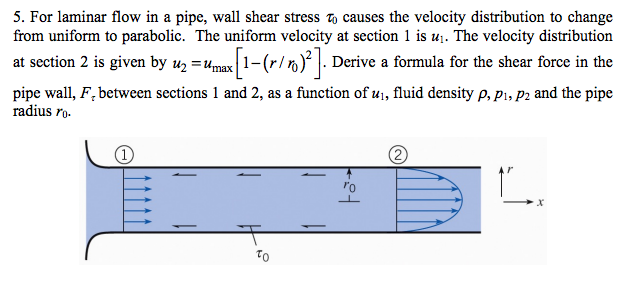
Those closest to the edge of the tube are moving slowly while those near the center are moving quickly.Assume the liquid exhibits laminar flow. b) A cross section of the tube shows the lamina moving at different speeds. In standard fluid-kinetics notation: Δ p = 8 μ L Q π R 4 = 8 π μ L Q A 2 Ī) A tube showing the imaginary lamina. Both effects contribute to the actual pressure drop. However, the viscosity of blood will cause additional pressure drop along the direction of flow, which is proportional to length traveled (as per Poiseuille's law).
#Laminar flow pipe plus#
For example, the pressure needed to drive a viscous fluid up against gravity would contain both that as needed in Poiseuille's law plus that as needed in Bernoulli's equation, such that any point in the flow would have a pressure greater than zero (otherwise no flow would happen).Īnother example is when blood flows into a narrower constriction, its speed will be greater than in a larger diameter (due to continuity of volumetric flow rate), and its pressure will be lower than in a larger diameter (due to Bernoulli's equation). Poiseuille's equation describes the pressure drop due to the viscosity of the fluid other types of pressure drops may still occur in a fluid (see a demonstration here). For velocities and pipe diameters above a threshold, actual fluid flow is not laminar but turbulent, leading to larger pressure drops than calculated by the Hagen–Poiseuille equation. The assumptions of the equation are that the fluid is incompressible and Newtonian the flow is laminar through a pipe of constant circular cross-section that is substantially longer than its diameter and there is no acceleration of fluid in the pipe. The theoretical justification of the Poiseuille law was given by George Stokes in 1845. It was experimentally derived independently by Jean Léonard Marie Poiseuille in 1838 and Gotthilf Heinrich Ludwig Hagen, and published by Poiseuille in 1840–. It can be successfully applied to air flow in lung alveoli, or the flow through a drinking straw or through a hypodermic needle. The convection and conduction heat flows are parallel to each other and to the surface normal of the boundary surface, and are all perpendicular to the mean fluid flow in the simple case.In nonideal fluid dynamics, the Hagen–Poiseuille equation, also known as the Hagen–Poiseuille law, Poiseuille law or Poiseuille equation, is a physical law that gives the pressure drop in an incompressible and Newtonian fluid in laminar flow flowing through a long cylindrical pipe of constant cross section. The Nusselt number is the ratio of convective to conductive heat transfer across a boundary. The mass transfer analogue of the Nusselt number is the Sherwood number. Ī similar non-dimensional property is the Biot number, which concerns thermal conductivity for a solid body rather than a fluid. A larger Nusselt number corresponds to more active convection, with turbulent flow typically in the 100–1000 range. : 336 A value between one (zero) and 10 is characteristic of slug flow or laminar flow.

: 466Ī Nusselt number of value one (zero) represents heat transfer by pure conduction. It is a dimensionless number, closely related to the fluid's Rayleigh number. The conductive component is measured under the same conditions as the convective but for a hypothetically motionless fluid.

Convection includes both advection (fluid motion) and diffusion (conduction).

In thermal fluid dynamics, the Nusselt number ( Nu, after Wilhelm Nusselt : 336 ) is the ratio of convective to conductive heat transfer at a boundary in a fluid. Ratio of a fluid's rates of convective and conductive heat transfer


 0 kommentar(er)
0 kommentar(er)
